Jennie Walters's Blog
September 5, 2013
Discovering the real Swallowcliffe
 When I first had the idea some ten years ago to write a set of books set in an English country house, perhaps the most important thing to decide was what to call my house and thus the series. I made a list of various grand-sounding Abbeys, Manors, Houses and Places and sent them to my editor at Simon and Schuster for her to mull over. We both liked the lyrical rhythm of Swallowcliffe Hall, which seemed to conjure up exactly the right blend of rural beauty and history. I looked in a road map of the British Isles to make sure there wasn't already a place called Swallowcliffe which might have a Hall in it (not wanting to ascribe a fictional history to a real place), but didn't find anything, so started writing.
When I first had the idea some ten years ago to write a set of books set in an English country house, perhaps the most important thing to decide was what to call my house and thus the series. I made a list of various grand-sounding Abbeys, Manors, Houses and Places and sent them to my editor at Simon and Schuster for her to mull over. We both liked the lyrical rhythm of Swallowcliffe Hall, which seemed to conjure up exactly the right blend of rural beauty and history. I looked in a road map of the British Isles to make sure there wasn't already a place called Swallowcliffe which might have a Hall in it (not wanting to ascribe a fictional history to a real place), but didn't find anything, so started writing.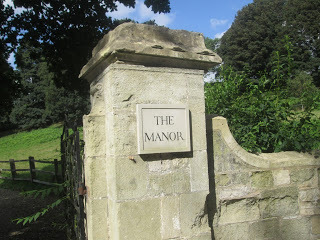 A couple of years later, when the second book in the series, 'Grace's Story', had just been published, I idly Googled 'Swallowcliffe' - only to discover that there was in fact a Swallowcliffe village, with its own website. How could I have missed it? (I'm actually glad I did, because I might have chosen another name for my series and now I can't imagine it being called anything else.) At any rate, I contacted the person who ran the site to tell him about my books. When he gave me his surname, I nearly dropped the phone. It was Stanbury: the same as that of my heroine, Grace. What are the chances of that? Of course on one level, it's just a random coincidence, but on another, it makes me feel I have some kind of connection with Swallowcliffe, that my stories were waiting to be written and that there's a certain inevitability to the framing of them. Chris Stanbury told me there was a large house in the village, though it's Swallowcliffe Manor rather than Swallowcliffe Hall (which I'm also rather glad about). Ooh, I thought idly, I wonder what it's like? Perhaps one day I should set off to the village and see if I could catch a glimpse...
A couple of years later, when the second book in the series, 'Grace's Story', had just been published, I idly Googled 'Swallowcliffe' - only to discover that there was in fact a Swallowcliffe village, with its own website. How could I have missed it? (I'm actually glad I did, because I might have chosen another name for my series and now I can't imagine it being called anything else.) At any rate, I contacted the person who ran the site to tell him about my books. When he gave me his surname, I nearly dropped the phone. It was Stanbury: the same as that of my heroine, Grace. What are the chances of that? Of course on one level, it's just a random coincidence, but on another, it makes me feel I have some kind of connection with Swallowcliffe, that my stories were waiting to be written and that there's a certain inevitability to the framing of them. Chris Stanbury told me there was a large house in the village, though it's Swallowcliffe Manor rather than Swallowcliffe Hall (which I'm also rather glad about). Ooh, I thought idly, I wonder what it's like? Perhaps one day I should set off to the village and see if I could catch a glimpse...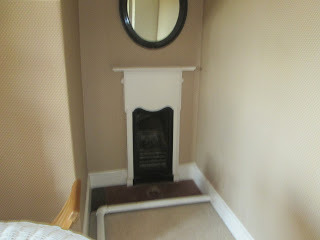 And then a month or so ago, the new owners of Swallowcliffe Manor contacted me out of the blue via my website with the most wonderfully generous offer: they'd be happy to show me round the house any time I'd like. I couldn't quite believe it, but as luck would have it, we happened to be driving within a few miles of Swallowcliffe on my birthday. Could there be a more perfect way to celebrate? I spent an hour or so exploring the nooks and crannies of this lovely house, from the cellar staircase up to the attic bedrooms where servants would once have slept - two floors at opposite ends of the house, one for female staff and one for male, we guessed, with tiny little fireplaces. (One fascinating fact: the attic bedrooms look out over the front of the house while the grander bedrooms look on to the garden; the servants could keep an eye on who was arriving at the house rather than spying on the family at their leisure!) Swallowcliffe Manor actually looks very like the house I photographed for my book covers, Creech Grange in Dorset - although I must admit the description of my fictional Swallowcliffe Hall was based on Kingston Lacy, a rather larger house. The Manor was built in the seventeenth century as a farmhouse, part of the estate of the Earl of Pembroke, and was skilfully extended in the 1920s.
And then a month or so ago, the new owners of Swallowcliffe Manor contacted me out of the blue via my website with the most wonderfully generous offer: they'd be happy to show me round the house any time I'd like. I couldn't quite believe it, but as luck would have it, we happened to be driving within a few miles of Swallowcliffe on my birthday. Could there be a more perfect way to celebrate? I spent an hour or so exploring the nooks and crannies of this lovely house, from the cellar staircase up to the attic bedrooms where servants would once have slept - two floors at opposite ends of the house, one for female staff and one for male, we guessed, with tiny little fireplaces. (One fascinating fact: the attic bedrooms look out over the front of the house while the grander bedrooms look on to the garden; the servants could keep an eye on who was arriving at the house rather than spying on the family at their leisure!) Swallowcliffe Manor actually looks very like the house I photographed for my book covers, Creech Grange in Dorset - although I must admit the description of my fictional Swallowcliffe Hall was based on Kingston Lacy, a rather larger house. The Manor was built in the seventeenth century as a farmhouse, part of the estate of the Earl of Pembroke, and was skilfully extended in the 1920s.
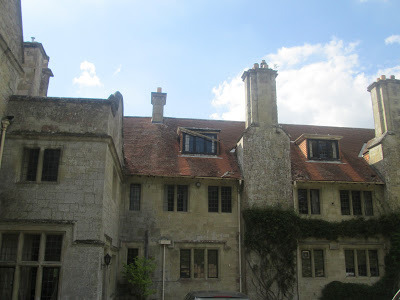 The most wonderful thing I discovered about Swallowcliffe Manor, though, is that it's going to become a much-loved family home. There might not be a fleet of uniformed housemaids running up and down stairs but there will be children enjoying Christmases, birthdays, and who knows, maybe weddings one day in this magical place. A new chapter in the house's history is about to begin. It has found exactly the right people to cherish and preserve it, while taking it into the twenty-first century with the help of solar energy and other green technologies. I wish them many happy years there as they create real-life stories of their own...
The most wonderful thing I discovered about Swallowcliffe Manor, though, is that it's going to become a much-loved family home. There might not be a fleet of uniformed housemaids running up and down stairs but there will be children enjoying Christmases, birthdays, and who knows, maybe weddings one day in this magical place. A new chapter in the house's history is about to begin. It has found exactly the right people to cherish and preserve it, while taking it into the twenty-first century with the help of solar energy and other green technologies. I wish them many happy years there as they create real-life stories of their own...
 The view from Swallowcliffe village
The view from Swallowcliffe village
Published on September 05, 2013 14:16
August 4, 2013
Should auld acquaintance be forgot...
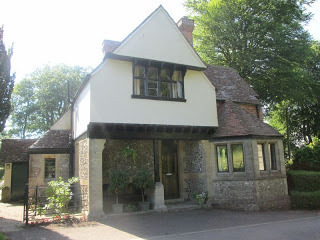 Over the crest of the hill, and here’s the village: the garage on the right, next to the social club where my father arrived to collect me from my first dance at 10 pm (oh, the shame); further down the road, the small hotel where I got my first holiday job as washer-up and later, less successfully, waitress. (‘She’s probably tired,’ I once overheard a kindly woman murmur.) Turning left through the tall gates, I pass the lodge where my family lived while my father was bursar at the school; shortly before he moved to another job in the Midlands, I joined the sixth-form as a boarder. Here’s the first bend in the drive where my friends and I would hide in the bushes, waiting for the taxi to take us off on illicit pub crawls.
Over the crest of the hill, and here’s the village: the garage on the right, next to the social club where my father arrived to collect me from my first dance at 10 pm (oh, the shame); further down the road, the small hotel where I got my first holiday job as washer-up and later, less successfully, waitress. (‘She’s probably tired,’ I once overheard a kindly woman murmur.) Turning left through the tall gates, I pass the lodge where my family lived while my father was bursar at the school; shortly before he moved to another job in the Midlands, I joined the sixth-form as a boarder. Here’s the first bend in the drive where my friends and I would hide in the bushes, waiting for the taxi to take us off on illicit pub crawls. 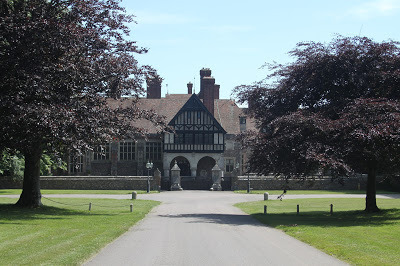 Another bend and the school itself lies before me, drowsing in the sun: still beautiful, though inevitably smaller than I remember, and so quiet! Cows graze in the overgrown fields where we used to watch the boys playing rugby in the bitter autumn wind, or cricket under a blazing sun (the weather being always seasonally appropriate in my memory), and where I tried to keep well away from the action during mixed hockey. The groundsmen who once kept the turf immaculate must all be dead by now – and so is my father, who would patrol these grounds with an eagle eye. The entire school budget was controlled from his nerve centre of an office, its walls covered with complicated charts in those unimaginable pre-computer days.
Another bend and the school itself lies before me, drowsing in the sun: still beautiful, though inevitably smaller than I remember, and so quiet! Cows graze in the overgrown fields where we used to watch the boys playing rugby in the bitter autumn wind, or cricket under a blazing sun (the weather being always seasonally appropriate in my memory), and where I tried to keep well away from the action during mixed hockey. The groundsmen who once kept the turf immaculate must all be dead by now – and so is my father, who would patrol these grounds with an eagle eye. The entire school budget was controlled from his nerve centre of an office, its walls covered with complicated charts in those unimaginable pre-computer days. A long-forgotten memory re-surfaces: I’m walking across the field when I feel an urge to see how far I can hurl one of my clogs into the air with my foot. The next second I’m gazing up at the sky, winded, but wanting to laugh at the ridiculousness of it all, having overbalanced and fallen flat on my back. Now I’m lying on the same patch of ground, staring up into the same blue sky as I call my husband on a mobile phone to say that I’ve safely arrived. Somehow I’ve become an adult, too sensible to hurl my footwear about for no apparent reason, and I’m back here to spend the weekend with seven of the girls (sorry, women) who were at school with me, forty years ago.
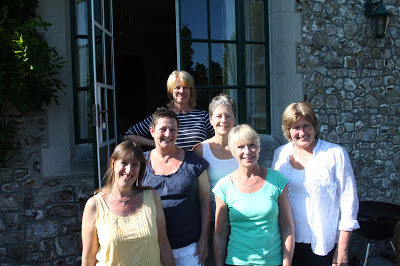 There were twelve of us starting together at this boys’ public school which had recently started taking girls in the sixth form; we were the second year’s intake. No longer a school, the sprawling Victorian estate has recently been split into separate properties, renovated and sold to private individuals. Everything has been turned into accommodation, including the sports pavilion, the bothy where the kitchen staff once lived and quite possibly the chapel, too. New red-brick houses are being built in the lovely old walled garden where the shooting range used to be. The cottage we are renting for this weekend’s magical memory tour might have once been a housemaster’s quarters, classrooms perhaps, or maybe a boys’ common room. Nobody can quite remember.
There were twelve of us starting together at this boys’ public school which had recently started taking girls in the sixth form; we were the second year’s intake. No longer a school, the sprawling Victorian estate has recently been split into separate properties, renovated and sold to private individuals. Everything has been turned into accommodation, including the sports pavilion, the bothy where the kitchen staff once lived and quite possibly the chapel, too. New red-brick houses are being built in the lovely old walled garden where the shooting range used to be. The cottage we are renting for this weekend’s magical memory tour might have once been a housemaster’s quarters, classrooms perhaps, or maybe a boys’ common room. Nobody can quite remember. 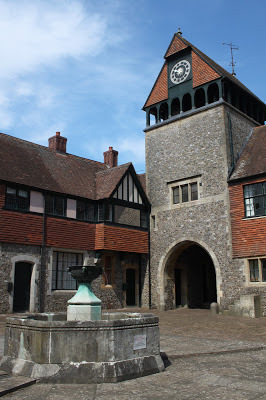
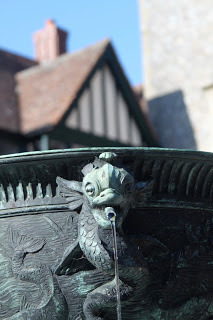 We’re all a little shell-shocked, to be honest, gazing round the courtyard (was there a fountain in our day?) as we try to place these strangely familiar landmarks within the hazy landscape of the past. Only one of us can locate the girls’ cloakroom, where apparently there used to be toilets and lockers for our bags (this is a blank to me), and the walled garden holds more significance for some (the smokers) than others. We want to sneak into the main building to find out whether the stuffed birds in their glass cases, the vast marble staircase and the mosaic floors are still there, but despite bumping into the man who owns this part of the house and dropping heavy hints, it remains closed to us. Perhaps it’s just as well; there’s only so much reminiscence one can take. Today, flowery curtains flutter at the window of the sanatorium while picnic tables and garden umbrellas stretch along the terrace. I remember an outdoor religious studies lesson being interrupted one sunny afternoon by a white horse galloping down that same terrace and leaping over a stone wall before our startled eyes; a surreal experience even at the time.
We’re all a little shell-shocked, to be honest, gazing round the courtyard (was there a fountain in our day?) as we try to place these strangely familiar landmarks within the hazy landscape of the past. Only one of us can locate the girls’ cloakroom, where apparently there used to be toilets and lockers for our bags (this is a blank to me), and the walled garden holds more significance for some (the smokers) than others. We want to sneak into the main building to find out whether the stuffed birds in their glass cases, the vast marble staircase and the mosaic floors are still there, but despite bumping into the man who owns this part of the house and dropping heavy hints, it remains closed to us. Perhaps it’s just as well; there’s only so much reminiscence one can take. Today, flowery curtains flutter at the window of the sanatorium while picnic tables and garden umbrellas stretch along the terrace. I remember an outdoor religious studies lesson being interrupted one sunny afternoon by a white horse galloping down that same terrace and leaping over a stone wall before our startled eyes; a surreal experience even at the time. 
What else? French lessons in the clock tower spent listening to Edith Piaf records – our teacher being a bon viveur who, according to legend, would ride his motorbike down the school corridor after particularly indulgent evenings. Academic results weren’t distinguished in my day but we all have a fund of stories. Wasn’t there a boy who’d spend hours floating on his back out in the bay, reading rag mags, and once convinced a boatload of day trippers that he was French and had lost his way while swimming the Channel? The school was an anarchic sort of place, the perfect breeding ground for eccentrics.
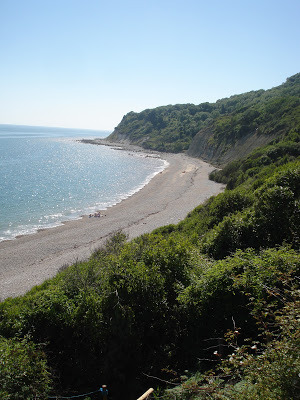 So many memories are tinged with a glamour that, beyond mere nostalgia, comes from the atmosphere of the estate itself and its extraordinary setting, perched above the Undercliff: a land-slip, time-slip, sub-tropical world of tangled tree canopy overhead and dense undergrowth below, home to acres of bluebells in spring and adders sliding along secret paths in summer. We would scramble through it in flip flops on our way down to the beach, with only the help of a rope to scale the sheerest part of the cliff. (Did I really do that?) There didn’t seem to be much supervision, especially not at weekends when, having returned to school from Friday-afternoon community service with our bags weighed down by bottles of gin, whisky and Tia Maria, we would disappear to various distant corners of the grounds to drink and smoke and try to have fun – or, more often than not, languish in the girls’ boarding house to the mournful strains of Harry Nilsson. (‘Can’t live if living is without you,’ takes us all right back there, we decide as we replay the soundtrack of our youth courtesy of Youtube.)
So many memories are tinged with a glamour that, beyond mere nostalgia, comes from the atmosphere of the estate itself and its extraordinary setting, perched above the Undercliff: a land-slip, time-slip, sub-tropical world of tangled tree canopy overhead and dense undergrowth below, home to acres of bluebells in spring and adders sliding along secret paths in summer. We would scramble through it in flip flops on our way down to the beach, with only the help of a rope to scale the sheerest part of the cliff. (Did I really do that?) There didn’t seem to be much supervision, especially not at weekends when, having returned to school from Friday-afternoon community service with our bags weighed down by bottles of gin, whisky and Tia Maria, we would disappear to various distant corners of the grounds to drink and smoke and try to have fun – or, more often than not, languish in the girls’ boarding house to the mournful strains of Harry Nilsson. (‘Can’t live if living is without you,’ takes us all right back there, we decide as we replay the soundtrack of our youth courtesy of Youtube.) 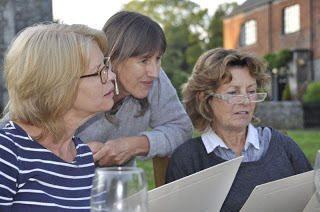
Some of us girls might have been confident enough to cope with the scrutiny that comes from being in a minority of 24 among 300 or so boys but, coming from an exclusively female school, I wasn’t one of them. I remember feeling agonizingly self-conscious and shy for much of the time. It’s so strange, walking down the same paths I would stumble along in my platform shoes as a gawky fifteen-year-old, with some of the same friends who have weirdly turned into middle-aged women.
 We’ve been meeting up once a year for the past four or five years, but this time is more significant; we’re spending a whole weekend in our former stamping ground. The place is soon casting its magic over us. We sink a few bottles of wine as the sun goes down (nobody admits to drinking Tia Maria any more) and talk about the old days. I feel safe, comfortable and supported. Could this be the perfect form of friendship? In some ways, we don’t know each other particularly well as adults – we don’t have mutual friends, we keep our children and partners separate, we only meet up infrequently – yet the intense experience we shared for two years as teenagers has given us a bond that still means something. After a previous reunion, somebody said, ‘It’s so funny: we’re all just like we used to be, only more so.’ Yet we seem to have learned how to become a little kinder to each other. There’s been the usual share of trauma and difficulty within our group – bereavement, illness, divorce, unfulfilled ambitions – but we can talk our experiences over without fear of being judged. Perhaps if we’d met up earlier, when we were in the throes of career and family, there might have been more rivalry; now enough water has flown under the bridge for us to take a longer view from the riverbank.
We’ve been meeting up once a year for the past four or five years, but this time is more significant; we’re spending a whole weekend in our former stamping ground. The place is soon casting its magic over us. We sink a few bottles of wine as the sun goes down (nobody admits to drinking Tia Maria any more) and talk about the old days. I feel safe, comfortable and supported. Could this be the perfect form of friendship? In some ways, we don’t know each other particularly well as adults – we don’t have mutual friends, we keep our children and partners separate, we only meet up infrequently – yet the intense experience we shared for two years as teenagers has given us a bond that still means something. After a previous reunion, somebody said, ‘It’s so funny: we’re all just like we used to be, only more so.’ Yet we seem to have learned how to become a little kinder to each other. There’s been the usual share of trauma and difficulty within our group – bereavement, illness, divorce, unfulfilled ambitions – but we can talk our experiences over without fear of being judged. Perhaps if we’d met up earlier, when we were in the throes of career and family, there might have been more rivalry; now enough water has flown under the bridge for us to take a longer view from the riverbank. 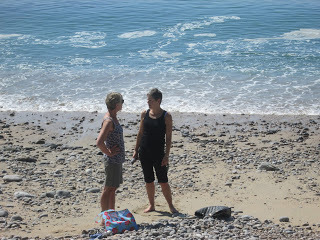 Although our children are mostly older now than we were then, my schoolfriends provide a link to the girl I used to be. They are dear to me for reasons I still don’t completely understand. I find myself unaccountably excited to see them; I care about their lives. Their presence helps me contemplate the past with a gentler eye, forgiving my awkward early steps towards adulthood. Is this a consolation that comes with age?
Although our children are mostly older now than we were then, my schoolfriends provide a link to the girl I used to be. They are dear to me for reasons I still don’t completely understand. I find myself unaccountably excited to see them; I care about their lives. Their presence helps me contemplate the past with a gentler eye, forgiving my awkward early steps towards adulthood. Is this a consolation that comes with age? ‘Look!’ I want to say. ‘We have come through!’
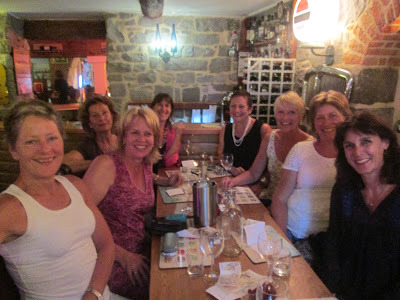 Here's a link to wonderful Middlemist cottage, where we stayed. Highly recommended, even if you haven't been to school there first... And special thanks to Karey Taylor and Jill Newton, for permission to reproduce some of their lovely photographs.
Here's a link to wonderful Middlemist cottage, where we stayed. Highly recommended, even if you haven't been to school there first... And special thanks to Karey Taylor and Jill Newton, for permission to reproduce some of their lovely photographs. 
Published on August 04, 2013 03:28
May 13, 2013
The power of the spoken word....
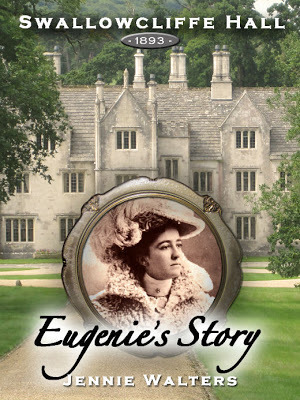 At a select gathering of writer friends last year, I read out an extract from the book I'd recently finished, Eugenie's Story. One creative and positive person (thanks, Yang-May) told me I had exactly the right sort of voice for my heroine and I ought to think about turning the story into an audiobook. I must confess, at first I thought, 'Yeah, right. How on earth am I going to do that?' but the idea lodged in the back of my mind. And when another friend mentioned he had a microphone and recording facilities in his study because he'd begun doing voiceovers, it seemed like Fate was giving me a nudge. Maybe narrating my own story wasn't such an impossible proposition after all. I had no idea what I'd do with the recording once it was finished, but it might be fun to have a go. Audiobooks are becoming more and more popular as people multi-task their way through busy lives, listening to stories while they exercise, travel or do the housework. I also felt the humour in the story - the gap between Eugenie's inflated idea of herself and reality - would come out particularly clearly if it was read aloud. At the very least, if I'm knocked down by a bus tomorrow, there'll be some record of my dulcet tones for posterity.
At a select gathering of writer friends last year, I read out an extract from the book I'd recently finished, Eugenie's Story. One creative and positive person (thanks, Yang-May) told me I had exactly the right sort of voice for my heroine and I ought to think about turning the story into an audiobook. I must confess, at first I thought, 'Yeah, right. How on earth am I going to do that?' but the idea lodged in the back of my mind. And when another friend mentioned he had a microphone and recording facilities in his study because he'd begun doing voiceovers, it seemed like Fate was giving me a nudge. Maybe narrating my own story wasn't such an impossible proposition after all. I had no idea what I'd do with the recording once it was finished, but it might be fun to have a go. Audiobooks are becoming more and more popular as people multi-task their way through busy lives, listening to stories while they exercise, travel or do the housework. I also felt the humour in the story - the gap between Eugenie's inflated idea of herself and reality - would come out particularly clearly if it was read aloud. At the very least, if I'm knocked down by a bus tomorrow, there'll be some record of my dulcet tones for posterity.
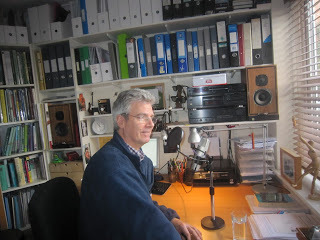 Patient producer, SimonSo a few weeks later, I set off on the train with Eugenie's Story loaded on my Kindle and butterflies in my stomach. Would my friend Simon, who'd kindly agreed to act as my producer, be driven to exasperation as I fluffed and fumbled my way through the reading? Would I sound too amateurish? Could I possibly produce a convincing Irish or American accent? (The story takes the form of Eugenie's diary but there's a certain amount of dialogue from her American friends and a dashing young Irishman.) I'd practised by reading the whole story through at least once, and the difficult sections several times (it's a lot harder than you might realize to say the words 'off on an adventure', for example - just try it and see), but even so, I was distinctly nervous.
Patient producer, SimonSo a few weeks later, I set off on the train with Eugenie's Story loaded on my Kindle and butterflies in my stomach. Would my friend Simon, who'd kindly agreed to act as my producer, be driven to exasperation as I fluffed and fumbled my way through the reading? Would I sound too amateurish? Could I possibly produce a convincing Irish or American accent? (The story takes the form of Eugenie's diary but there's a certain amount of dialogue from her American friends and a dashing young Irishman.) I'd practised by reading the whole story through at least once, and the difficult sections several times (it's a lot harder than you might realize to say the words 'off on an adventure', for example - just try it and see), but even so, I was distinctly nervous.
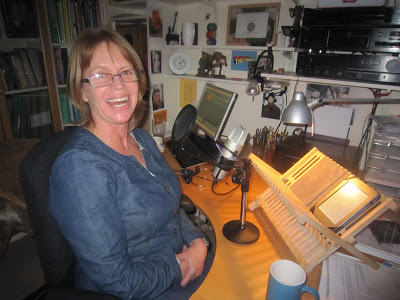 Unfortunately it looks like I've cut my own hair with nail scissors.
Unfortunately it looks like I've cut my own hair with nail scissors. Just as well this is radio and not TV Well, as things turned out, I didn't need to worry. Once I'd hit my stride, things flowed very smoothly and the whole experience was a blast. I've noticed before that most authors seem to enjoy reading their work out loud; we have to be a little bit in love with what we write, otherwise we couldn't keep pounding away at it day after day. It was a huge treat for me to spend two solid days in Eugenie's company - and although it can't have been quite such fun for Simon, he bore the ordeal with great patience. Lots of coffee and biscuit breaks, visits from the resident studio dog, Harry, eggs from the resident studio hens for breakfast - what more could a wannabe thespian want? I won't ever pass for a native American or Irishwoman but actually, this is Eugenie telling her story, and I don't think she'd be very good at accents either, so that's all right.
 Harry, the studio dogOnce Simon had cleaned up various fluffs and lip-smackings, we were left with nearly 7 hours of recording and it was time to call in the experts. The wonder of the internet led me to OpenBookAudio, a production and distribution company staffed by kindly elves - no, in fact by Andrew and Matt (amongst others), who have magically enabled Eugenie's Story to be stocked by retailers and offered up for sale! And what's more, you can even hear the beginning free, gratis and for nothing by clicking here. Could that be any more exciting?
Harry, the studio dogOnce Simon had cleaned up various fluffs and lip-smackings, we were left with nearly 7 hours of recording and it was time to call in the experts. The wonder of the internet led me to OpenBookAudio, a production and distribution company staffed by kindly elves - no, in fact by Andrew and Matt (amongst others), who have magically enabled Eugenie's Story to be stocked by retailers and offered up for sale! And what's more, you can even hear the beginning free, gratis and for nothing by clicking here. Could that be any more exciting?No, I don't think it could. Have a listen and see if you agree...
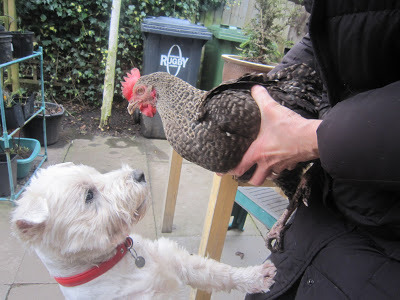 And Henny Penny, one of the studio chickens
And Henny Penny, one of the studio chickens
Published on May 13, 2013 11:33
April 9, 2013
Spirit of Place
'For one moment Swallowcliffe belonged to me. The lake, and the trees, and the sky above - even the house itself - were as much mine as they were anybody’s, because I had become a part of them and they were a part of me. Perhaps I would not vanish into thin air when the time came to go but leave something of myself behind. The next girl to sleep in that bed under the window might wake up one morning with a dream of me in her head, even though she would not know where it had come from, or quite what it was.'
From Polly's Story
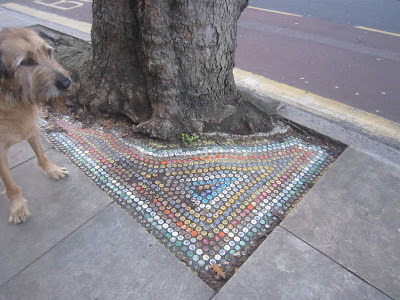
Writing the Swallowcliffe Hall books has made me think about the impact a place can have on a person: the importance of the familiar sights we see every day, and the effect our surroundings can have on our state of mind. I've lived within the same four or five mile area of South London for nearly thirty years, with a couple of exciting years' time out in Johannesburg, and most of the time I walk about with my head in the air, thinking random thoughts instead of noticing or appreciating. So here is a tribute to a few of the things that I love about the place I live, in no particular order:
The flowerbed in the pavement outside the tapas bar, which has been painstakingly decorated with beer bottle tops.
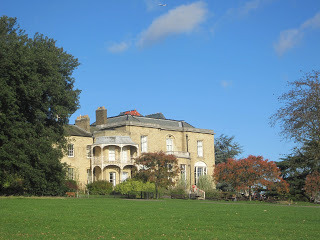 The trees in the park where I walk my dog, and the Georgian house at the top of the hill in the middle.
The trees in the park where I walk my dog, and the Georgian house at the top of the hill in the middle.
Bumping into people I know when nipping out to the shops or for a takeaway coffee.
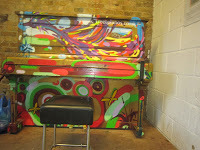 The communal piano outside the station that's free for anyone to use.
The communal piano outside the station that's free for anyone to use.
The farmers' market on Sundays where you can buy meat, fish, organic veg, street food and all kinds of other interesting things. Last week there were petting lambs! And rabbits!

The fact I can jump on a bus and be up at the South Bank in 30 minutes, or travel through London to St Pancras in the north by train in the same amount of time. London is my oyster...
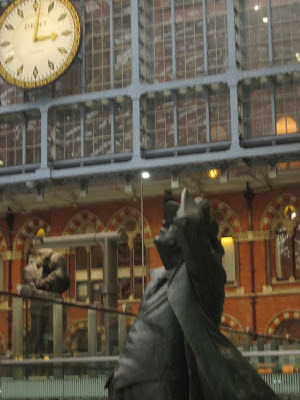 The statue of John Betjeman at St Pancras I love the idea that this isn't just a one-way street: that you might have an impact on your environment as well as vice versa (something I was trying to explore when describing Polly's feelings when knows she has to leave Swallowcliffe Hall). As Karen Blixen put it so beautifully in Out of Africa:
The statue of John Betjeman at St Pancras I love the idea that this isn't just a one-way street: that you might have an impact on your environment as well as vice versa (something I was trying to explore when describing Polly's feelings when knows she has to leave Swallowcliffe Hall). As Karen Blixen put it so beautifully in Out of Africa:
“If I know a song of Africa, of the giraffe and the African new moon lying on her back, of the ploughs in the fields and the sweaty faces of the coffee pickers, does Africa know a song of me? Will the air over the plain quiver with a colour that I have had on, or the children invent a game in which my name is, or the full moon throw a shadow over the gravel of the drive that was like me, or will the eagles of the Ngong Hills look out for me?”

So what's special about the place where you live?
From Polly's Story

Writing the Swallowcliffe Hall books has made me think about the impact a place can have on a person: the importance of the familiar sights we see every day, and the effect our surroundings can have on our state of mind. I've lived within the same four or five mile area of South London for nearly thirty years, with a couple of exciting years' time out in Johannesburg, and most of the time I walk about with my head in the air, thinking random thoughts instead of noticing or appreciating. So here is a tribute to a few of the things that I love about the place I live, in no particular order:
The flowerbed in the pavement outside the tapas bar, which has been painstakingly decorated with beer bottle tops.
 The trees in the park where I walk my dog, and the Georgian house at the top of the hill in the middle.
The trees in the park where I walk my dog, and the Georgian house at the top of the hill in the middle.Bumping into people I know when nipping out to the shops or for a takeaway coffee.
 The communal piano outside the station that's free for anyone to use.
The communal piano outside the station that's free for anyone to use.The farmers' market on Sundays where you can buy meat, fish, organic veg, street food and all kinds of other interesting things. Last week there were petting lambs! And rabbits!

The fact I can jump on a bus and be up at the South Bank in 30 minutes, or travel through London to St Pancras in the north by train in the same amount of time. London is my oyster...
 The statue of John Betjeman at St Pancras I love the idea that this isn't just a one-way street: that you might have an impact on your environment as well as vice versa (something I was trying to explore when describing Polly's feelings when knows she has to leave Swallowcliffe Hall). As Karen Blixen put it so beautifully in Out of Africa:
The statue of John Betjeman at St Pancras I love the idea that this isn't just a one-way street: that you might have an impact on your environment as well as vice versa (something I was trying to explore when describing Polly's feelings when knows she has to leave Swallowcliffe Hall). As Karen Blixen put it so beautifully in Out of Africa: “If I know a song of Africa, of the giraffe and the African new moon lying on her back, of the ploughs in the fields and the sweaty faces of the coffee pickers, does Africa know a song of me? Will the air over the plain quiver with a colour that I have had on, or the children invent a game in which my name is, or the full moon throw a shadow over the gravel of the drive that was like me, or will the eagles of the Ngong Hills look out for me?”

So what's special about the place where you live?
Published on April 09, 2013 12:46
March 20, 2013
Magical history in the heart of London
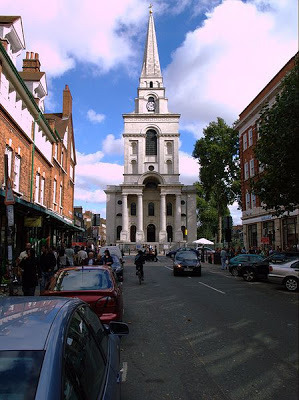 Christ Church, SpitalfieldsAlthough I've lived in London for years, there are still parts of the city I don't know at all. Spitalfields is one of them. Over the past few years, this once-shabby corner of the East End has picked itself up, dusted itself down and emerged as a vibrantly multi-cultural area, crammed with cutting-edge shops and offices, artists' studios, street markets (including Petticoat Lane and the amazing Sunday-morning Columbia Road flower market) and a thousand good places to eat, from uber-cool steakhouses to the Bangladeshi restaurants of Brick Lane.
Christ Church, SpitalfieldsAlthough I've lived in London for years, there are still parts of the city I don't know at all. Spitalfields is one of them. Over the past few years, this once-shabby corner of the East End has picked itself up, dusted itself down and emerged as a vibrantly multi-cultural area, crammed with cutting-edge shops and offices, artists' studios, street markets (including Petticoat Lane and the amazing Sunday-morning Columbia Road flower market) and a thousand good places to eat, from uber-cool steakhouses to the Bangladeshi restaurants of Brick Lane.
Spitalfields has played an important part in the history of London. After the Great Fire in 1666, traders began operating outside the inner City's walls, and in 1682 King Charles granted permission by royal decree for a market to be held on Thursdays and Saturdays near Spital Square. The market became a huge sucess and people began to settle in this formerly rural area of fields and streams - among them French Hugenots, fleeing France as anti-Protestant feeling grew in that country towards the end of the seventeenth century. Hugenot master silk-weavers were attracted by the new commercial area of Spitalfields and some settled in elegant houses there, followed by poorer Irish immigrants escaping the potato famine, Spitalfields has played an important part in the history of London. After the Great Fire in 1666, traders began operating outside the inner City's walls, and in 1682 King Charles granted permission by royal decree for a market to be held on Thursdays and Saturdays near Spital Square. The market became a huge sucess and people began to settle in this formerly rural area of fields and streams - among them French Hugenots, fleeing France as anti-Protestant feeling grew in that country towards the end of the seventeenth century. Hugenot master silk-weavers were attracted by the new commercial area of Spitalfields and some settled in elegant and later still by Jewish settlers from Eastern Europe and the Netherlands. At one time predominantly Jewish, in the twentieth century Spitalfields became the heart of the Bangladeshi community in London, and today the best bagel bars in London rub shoulders with the best curry houses.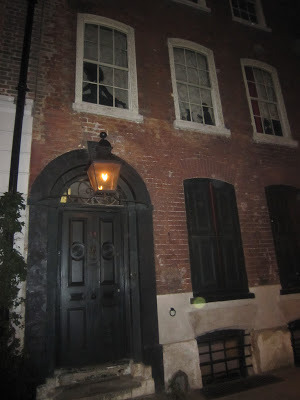 Traces of this historical pedigree remain, and one of the most enchanting is Dennis Severs' house in Folgate Street. This house, which dates from around 1724, was rescued from dereliction by Dennis Severs, who spent years restoring it and turning it into - not so much a museum as a piece of living history, or performance art. Visitors wander through each of the ten rooms (in silence, please, phones switched off and NO cameras!), observing minutiae from the lives of the imaginary Jervis family who have, seemingly, just popped out: a snatch of conversation from the hall, a wig thrown over the chair, a letter half-read at the breakfast table, the smell of food wafting up from the basement kitchen. Up the four floors we climb, to the shabby rooms at the top which are rented out to a weaver's family, and where the recorded tolling of a bell announces the death of King William IV and Queen Victoria's accession to the throne in 1837.
Traces of this historical pedigree remain, and one of the most enchanting is Dennis Severs' house in Folgate Street. This house, which dates from around 1724, was rescued from dereliction by Dennis Severs, who spent years restoring it and turning it into - not so much a museum as a piece of living history, or performance art. Visitors wander through each of the ten rooms (in silence, please, phones switched off and NO cameras!), observing minutiae from the lives of the imaginary Jervis family who have, seemingly, just popped out: a snatch of conversation from the hall, a wig thrown over the chair, a letter half-read at the breakfast table, the smell of food wafting up from the basement kitchen. Up the four floors we climb, to the shabby rooms at the top which are rented out to a weaver's family, and where the recorded tolling of a bell announces the death of King William IV and Queen Victoria's accession to the throne in 1837.
A short walk from the steel and glass of Liverpool Street Station along a busy road lined with office blocks, Dennis Severs' house is a wonderful time capsule in the midst of this modernity. The rooms are lit only by the flickering of open log fires and candles dotted here and there, and walking through them gives a wonderful sense of what it must have been like to live in one of these narrow townhouses. Down in the basement kitchen, the wooden ceiling planks only inches above your head make you feel trapped, desperate for fresh air and a glimpse of the outside world beyond the street grating. Up in the draughty attic rooms, with their plaster and lathe ceilings open to the roof space, a whole family poor as church mice must somehow scratch out a living. And in between, the lavish drawing and music rooms, elaborately decorated and crammed with china, furniture and nick-nacks, create an entirely different atmosphere of leisure and refinement.
Anyone in search of inspiration need look no further! That's one of the things I love most about London: the (occasionally eccentric) pockets of history you can stumble across, around the corner from a gleaming tower block...
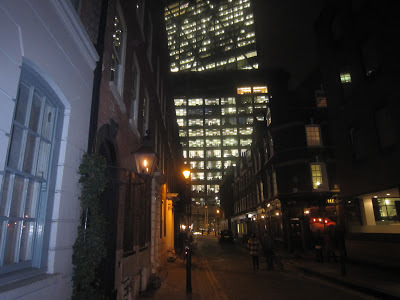
 Christ Church, SpitalfieldsAlthough I've lived in London for years, there are still parts of the city I don't know at all. Spitalfields is one of them. Over the past few years, this once-shabby corner of the East End has picked itself up, dusted itself down and emerged as a vibrantly multi-cultural area, crammed with cutting-edge shops and offices, artists' studios, street markets (including Petticoat Lane and the amazing Sunday-morning Columbia Road flower market) and a thousand good places to eat, from uber-cool steakhouses to the Bangladeshi restaurants of Brick Lane.
Christ Church, SpitalfieldsAlthough I've lived in London for years, there are still parts of the city I don't know at all. Spitalfields is one of them. Over the past few years, this once-shabby corner of the East End has picked itself up, dusted itself down and emerged as a vibrantly multi-cultural area, crammed with cutting-edge shops and offices, artists' studios, street markets (including Petticoat Lane and the amazing Sunday-morning Columbia Road flower market) and a thousand good places to eat, from uber-cool steakhouses to the Bangladeshi restaurants of Brick Lane. Spitalfields has played an important part in the history of London. After the Great Fire in 1666, traders began operating outside the inner City's walls, and in 1682 King Charles granted permission by royal decree for a market to be held on Thursdays and Saturdays near Spital Square. The market became a huge sucess and people began to settle in this formerly rural area of fields and streams - among them French Hugenots, fleeing France as anti-Protestant feeling grew in that country towards the end of the seventeenth century. Hugenot master silk-weavers were attracted by the new commercial area of Spitalfields and some settled in elegant houses there, followed by poorer Irish immigrants escaping the potato famine, Spitalfields has played an important part in the history of London. After the Great Fire in 1666, traders began operating outside the inner City's walls, and in 1682 King Charles granted permission by royal decree for a market to be held on Thursdays and Saturdays near Spital Square. The market became a huge sucess and people began to settle in this formerly rural area of fields and streams - among them French Hugenots, fleeing France as anti-Protestant feeling grew in that country towards the end of the seventeenth century. Hugenot master silk-weavers were attracted by the new commercial area of Spitalfields and some settled in elegant and later still by Jewish settlers from Eastern Europe and the Netherlands. At one time predominantly Jewish, in the twentieth century Spitalfields became the heart of the Bangladeshi community in London, and today the best bagel bars in London rub shoulders with the best curry houses.
 Traces of this historical pedigree remain, and one of the most enchanting is Dennis Severs' house in Folgate Street. This house, which dates from around 1724, was rescued from dereliction by Dennis Severs, who spent years restoring it and turning it into - not so much a museum as a piece of living history, or performance art. Visitors wander through each of the ten rooms (in silence, please, phones switched off and NO cameras!), observing minutiae from the lives of the imaginary Jervis family who have, seemingly, just popped out: a snatch of conversation from the hall, a wig thrown over the chair, a letter half-read at the breakfast table, the smell of food wafting up from the basement kitchen. Up the four floors we climb, to the shabby rooms at the top which are rented out to a weaver's family, and where the recorded tolling of a bell announces the death of King William IV and Queen Victoria's accession to the throne in 1837.
Traces of this historical pedigree remain, and one of the most enchanting is Dennis Severs' house in Folgate Street. This house, which dates from around 1724, was rescued from dereliction by Dennis Severs, who spent years restoring it and turning it into - not so much a museum as a piece of living history, or performance art. Visitors wander through each of the ten rooms (in silence, please, phones switched off and NO cameras!), observing minutiae from the lives of the imaginary Jervis family who have, seemingly, just popped out: a snatch of conversation from the hall, a wig thrown over the chair, a letter half-read at the breakfast table, the smell of food wafting up from the basement kitchen. Up the four floors we climb, to the shabby rooms at the top which are rented out to a weaver's family, and where the recorded tolling of a bell announces the death of King William IV and Queen Victoria's accession to the throne in 1837.A short walk from the steel and glass of Liverpool Street Station along a busy road lined with office blocks, Dennis Severs' house is a wonderful time capsule in the midst of this modernity. The rooms are lit only by the flickering of open log fires and candles dotted here and there, and walking through them gives a wonderful sense of what it must have been like to live in one of these narrow townhouses. Down in the basement kitchen, the wooden ceiling planks only inches above your head make you feel trapped, desperate for fresh air and a glimpse of the outside world beyond the street grating. Up in the draughty attic rooms, with their plaster and lathe ceilings open to the roof space, a whole family poor as church mice must somehow scratch out a living. And in between, the lavish drawing and music rooms, elaborately decorated and crammed with china, furniture and nick-nacks, create an entirely different atmosphere of leisure and refinement.
Anyone in search of inspiration need look no further! That's one of the things I love most about London: the (occasionally eccentric) pockets of history you can stumble across, around the corner from a gleaming tower block...

Published on March 20, 2013 05:37
March 2, 2013
Secrets of success from a writers' conference...
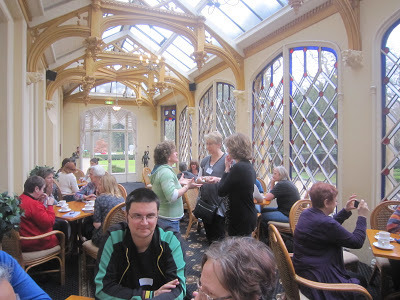 Spring has sprung! Despite not having managed to write a single blog for the entire month of February, I am looking to the future with renewed enthusiasm, determined to be more organized, more creative and more PRODUCTIVE. So what has sparked this fresh resolve? Well, I've just returned from a weekend meet-up/fiesta/brainstorm (conference sounds too formal) with the wonderful group of writers of which I'm a member, the Scattered Authors' Society. Apart from the pleasure of catching up with friends, swapping stories of writing and publishing ups and downs, and demolishing large amounts of good food and wine, we are also treated to talks by Sassies with particular areas of expertise or valuable experiences to share.
Spring has sprung! Despite not having managed to write a single blog for the entire month of February, I am looking to the future with renewed enthusiasm, determined to be more organized, more creative and more PRODUCTIVE. So what has sparked this fresh resolve? Well, I've just returned from a weekend meet-up/fiesta/brainstorm (conference sounds too formal) with the wonderful group of writers of which I'm a member, the Scattered Authors' Society. Apart from the pleasure of catching up with friends, swapping stories of writing and publishing ups and downs, and demolishing large amounts of good food and wine, we are also treated to talks by Sassies with particular areas of expertise or valuable experiences to share. 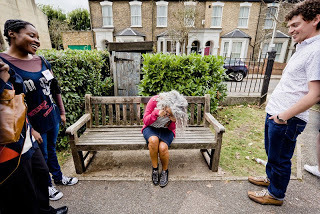 Catherine on the crying benchCatherine Johnson told us about her time on the prestigious BBC Writers' Academy training course (now sadly no longer running) and shared a few of its secrets for successful storylines. Amongst them: a five-act structure is more succcessful than a three-act; the nature of story is change; be surprising. Here's a photo of Catherine on the 'crying bench' from Eastenders, where the characters go to sob - weeping because the Writers' Academy scheme is finished. But Catherine's script-writing career with 'Continuous Drama' (soap operas to you and me) is about to go from strength to strength...
Catherine on the crying benchCatherine Johnson told us about her time on the prestigious BBC Writers' Academy training course (now sadly no longer running) and shared a few of its secrets for successful storylines. Amongst them: a five-act structure is more succcessful than a three-act; the nature of story is change; be surprising. Here's a photo of Catherine on the 'crying bench' from Eastenders, where the characters go to sob - weeping because the Writers' Academy scheme is finished. But Catherine's script-writing career with 'Continuous Drama' (soap operas to you and me) is about to go from strength to strength...Kate Harrison spoke about the way her life has changed since the publication (initially electronically on Kindle) of her book, The 5:2 Diet. Embarking on this diet, she couldn't find a book to guide her through, so wrote one herself. So not only did she find herself 23 pounds lighter, she soon had a bestseller soaring up the Amazon charts followed swiftly by a publishing contract for the print edition. Very encouraging! It brought home to me the flexibility of self-publishing: if you spot a trend, you needn't be deterred by lack of support from mainstream publishers. I've just ordered my copy of the book and am looking forward to losing some weight and boosting my brain power in time for summer.
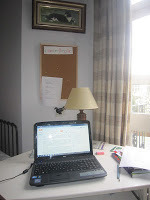
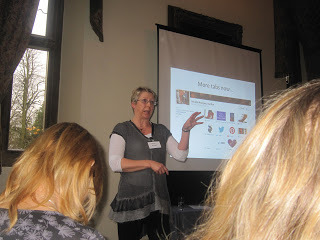 Just as inspiring, Nicola Morgan - writer, teen brain expert and social media guru - told us how to make best use of our Facebook author pages (the words 'custom tabs' featured heavily but didn't strike fear into the soul), and how to re-establish our sense of writerly purpose by means of the scary-sounding stimulus generalization! And now the secret of stimulus generalization can be yours, too. Basically, I think it boils down to ridding yourself of bad habits by changing the environment in which you work: either going to a different place (Nicola's new shed did the trick for her), or reorganizing/re-decorating/refreshing by some other means your existing study, or spare bedroom, or corner of the kitchen table. As well as revitalising my desk with a notice board and a picture of Rascal, my much-missed writing companion (see previous post), I've unleashed my inner neat freak and tidied up the kitchen, too.
Just as inspiring, Nicola Morgan - writer, teen brain expert and social media guru - told us how to make best use of our Facebook author pages (the words 'custom tabs' featured heavily but didn't strike fear into the soul), and how to re-establish our sense of writerly purpose by means of the scary-sounding stimulus generalization! And now the secret of stimulus generalization can be yours, too. Basically, I think it boils down to ridding yourself of bad habits by changing the environment in which you work: either going to a different place (Nicola's new shed did the trick for her), or reorganizing/re-decorating/refreshing by some other means your existing study, or spare bedroom, or corner of the kitchen table. As well as revitalising my desk with a notice board and a picture of Rascal, my much-missed writing companion (see previous post), I've unleashed my inner neat freak and tidied up the kitchen, too.Now I can't think of any more distractions, so all that's left to do is get on and WRITE! But perhaps I'll just look at Facebook first....
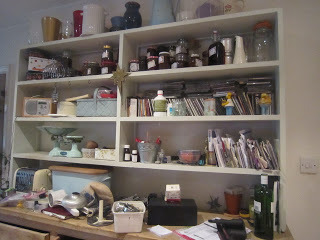 Kitchen dresser before...
Kitchen dresser before...
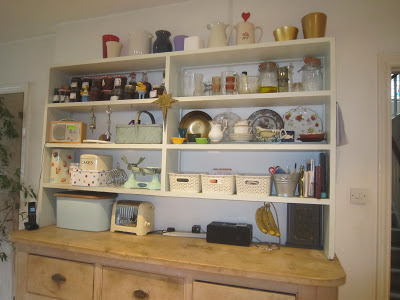 ... and after!
... and after!
Published on March 02, 2013 11:01
January 29, 2013
Changelings: A short story for a gloomy day
This is something I wrote for a workshop at the Winchester Writers' Conference a few years ago. One of my Facebook friends, Joyce McCombs, a librarian at Delta Junction in Alaska, was wondering whether anyone ever ran away from the circus to have an ordinary life - so Joyce, here is a story just for you!
 Changelings
Changelings
Arabis Elsworth walked slowly down the road, placing her feet very precisely along the edges of alternate paving stones. She was in no particular hurry to get home: her father would still be busy with the after-school drama club, and her mother was hosting a pottery party in her studio in the basement. Their house would be full of screaming seven-year-olds and odd, misshapen lumps of clay.
A girl was standing in the front garden of one of the houses, twirling a long chiffon scarf above her head. Arabis couldn’t remember having seen her before. Their eyes met.
‘Hello,’ said the girl, still twirling.
‘Hello,’ said Arabis.
‘What have you got there?’ The girl looked at the tie-dye shoebag slung over Arabis’s shoulder.
‘Tap shoes,’ Arabis replied. ‘I’ve just been to a class.’
‘Can I have a look? What size are they?’
Before Arabis knew quite what was happening, the tap shoes were out of the bag, and then on the girl’s feet, and she was showing her some basic steps on the pavement: heel-toe, toe-heel, click twice, heel again. She wasn’t bad, this girl - her footwork was rather sloppy, which was only to be expected from a beginner - but there was no need for all that business waving her arms about and pulling faces.
‘Do you want to come in for a drink?’ the girl said at last, blowing her fringe out of her eyes. She had long dark hair which needed a good brush, and her eyes were very blue.
Arabis knew better than to go anywhere with a stranger, but this girl was about her own age and the house looked tidy and well-kept. The patch of front lawn was immaculately trimmed, with extremely straight edges. For once, she decided to take a chance. ‘All right, I will,’ she said.
And then came the question she always dreaded. ‘What’s your name?’
Arabis began to frame the word. Then, perhaps because it was turning into such an unusual day, she suddenly said, ‘Ann. My name is Ann.’ Very decidedly, just like that. How easy it was! Why had she never thought of this before? ‘What’s yours?’
‘Sapphire. Sapphire Wilkinson,’ said the girl, shaking back her straggly hair. She led the way up their garden path, through the front door, down the hall and into a neat and tidy kitchen. There, she made two glasses of orange squash which they drank, looking at each other. Arabis could hear the sound of a television coming from somewhere else in the house. They didn’t have one at home: her parents said it stifled creativity.
‘Do you want to come up to my room?’ Sapphire asked. ‘I’ve got loads of costumes you could wear for dancing.’
As they walked back down the hall, a voice called out from the front room, ‘Susan? Is that you?’
Sapphire pulled a face. ‘Don’t say anything. Come on upstairs.’
Sapphire’s bedroom was knee-deep in clothes. It was hard to tell which were dressing-up clothes and which were ordinary weekend ones. After twenty minutes of trying things on (this was mostly Sapphire), Arabis asked hopefully, ‘Do you want to go and watch television?’
Sapphire shook her head. ‘It’ll just be one of those stupid game shows my parents like watching,’ she said, wrapping herself in a long velvet cloak.
‘I’d better go home, then,’ Arabis said. ‘See you. And thanks for the drink.’
‘Susan?’ called the voice again as she came downstairs, and a large, comfortable-looking lady in a cream cardigan looked out of the front room into the hall. ‘Oh, hello, dear. Are you a friend of Susan’s?’
‘Sapphire’s!’ came a shout from upstairs.
On the television, two teams of people were making up words out of a series of random letters. Arabis looked longingly at it through the open living-room door. She loved board games and crossword puzzles: there was something so satisfying about filling up the squares.
‘Would you like to watch for a while?’ Mrs Wilkinson said. ‘You’d be very welcome.’
Arabis sat next to Mr Wilkinson on the beige settee. There was a holder over one arm for the remote control, and pens, and a rolled-up newspaper. It was lovely - everything you could want was to hand. A dish of boiled sweets stood on top of a nest of three tables, stacked one under the other. Arabis could imagine Susan’s mother bringing out the tables, one for each of them, and the family having their supper together in front of the TV. Something easy to eat, most probably, like sausages on little sticks and sandwiches in triangles with the crusts cut off.
She watched the whole of the word programme with Susan’s parents - who didn’t seem to mind her being there at all - and afterwards she helped Mr Wilkinson with his crossword puzzle, and then she had to go home.
‘Come again, dear,’ Mrs Wilkinson said. ‘What’s your name, by the way?’
Arabis felt she ought to tell the truth this time.
‘Oh, that’s interesting.’ A startled look had come into Mrs Wilkinson’s eyes.
‘But people sometimes call me Ann,’ Arabis added quickly.
‘Certainly easier to get your tongue around,’ said Mr Wilkinson, folding up his newspaper for the recycling box.
Arabis found herself calling round at Susan/Sapphire’s house on her way back from tap class quite often after that, and soon it did not seem to matter whether Susan was there or not. Sometimes Susan stayed up in her room, twirling and thumping about, and didn’t even bother to come downstairs and say hello.
‘Wouldn’t you like to bring your little friend back here for a change?’ Arabis’s mother, Amber Elsworth, asked her one day. They were having tea in the pottery studio because her father’s drama group, the Thetford Thespians, were rehearsing their new play upstairs in the kitchen.
‘I can’t bring Sapphire here,’ Arabis said, balancing a heavy bowl of stir-fried beansprouts on her lap. ‘It’s too much of a muddle.’
‘Sapphire! What a beautiful name!’ Mrs Elsworth was delighted. ‘I’m sure she won’t mind a bit of mess.’
Sapphire didn’t. She loved everything about Arabis’s house, from the Native American dreamcatchers and wind chimes in the front garden to the authentic Mongolian yurt at the back. She had a second helping of Quorn and brown rice risotto, and a whole bowlful of Tofu whip, and then she performed a dance which she had been improvising for the occasion.
Arabis looked at her parents’ delighted faces. She didn’t feel jealous; it was as though she had brought them a lovely present, and that made her happy. Quietly she slipped out of the house and made her way over to Susan’s. There was a programme on television that evening about testing your IQ which she and the Wilkinsons had planned to watch together. It didn’t finish till late, so Arabis rang to ask her parents if she could stay over at Susan’s that night. They said of course, that was fine, and Sapphire might stay with them (if the Wilkinsons didn’t mind), since she was reading for a part with the Thetford Thespians.
At first it felt rather strange, sleeping in Susan’s bed. The next night, Arabis tidied away all the clothes into a large cardboard box and then the room seemed more like hers. She had popped home after school that day to collect a few things she needed, letting herself in with the spare key under the mat. The house had been empty so she’d left her parents a note, saying that she might stay at the Wilkinsons a little longer as the IQ programme was on every evening that week and she wouldn’t like to miss any of the episodes. They could contact her any time, since they knew exactly where she was.
Some months later, Arabis was sitting in the Wimpy in town, eating a sizzling steakburger. Amber Elsworth walked past the window, her arm around Sapphire’s tie-dyed shoulder. Their eyes met.
‘Eat up, Ann,’ Mrs Wilkinson said. ‘Is something the matter?’
‘No, nothing.’ Arabis quickly looked away. Her mother did the same.
 Changelings
Changelings Arabis Elsworth walked slowly down the road, placing her feet very precisely along the edges of alternate paving stones. She was in no particular hurry to get home: her father would still be busy with the after-school drama club, and her mother was hosting a pottery party in her studio in the basement. Their house would be full of screaming seven-year-olds and odd, misshapen lumps of clay.
A girl was standing in the front garden of one of the houses, twirling a long chiffon scarf above her head. Arabis couldn’t remember having seen her before. Their eyes met.
‘Hello,’ said the girl, still twirling.
‘Hello,’ said Arabis.
‘What have you got there?’ The girl looked at the tie-dye shoebag slung over Arabis’s shoulder.
‘Tap shoes,’ Arabis replied. ‘I’ve just been to a class.’
‘Can I have a look? What size are they?’
Before Arabis knew quite what was happening, the tap shoes were out of the bag, and then on the girl’s feet, and she was showing her some basic steps on the pavement: heel-toe, toe-heel, click twice, heel again. She wasn’t bad, this girl - her footwork was rather sloppy, which was only to be expected from a beginner - but there was no need for all that business waving her arms about and pulling faces.
‘Do you want to come in for a drink?’ the girl said at last, blowing her fringe out of her eyes. She had long dark hair which needed a good brush, and her eyes were very blue.
Arabis knew better than to go anywhere with a stranger, but this girl was about her own age and the house looked tidy and well-kept. The patch of front lawn was immaculately trimmed, with extremely straight edges. For once, she decided to take a chance. ‘All right, I will,’ she said.
And then came the question she always dreaded. ‘What’s your name?’
Arabis began to frame the word. Then, perhaps because it was turning into such an unusual day, she suddenly said, ‘Ann. My name is Ann.’ Very decidedly, just like that. How easy it was! Why had she never thought of this before? ‘What’s yours?’
‘Sapphire. Sapphire Wilkinson,’ said the girl, shaking back her straggly hair. She led the way up their garden path, through the front door, down the hall and into a neat and tidy kitchen. There, she made two glasses of orange squash which they drank, looking at each other. Arabis could hear the sound of a television coming from somewhere else in the house. They didn’t have one at home: her parents said it stifled creativity.
‘Do you want to come up to my room?’ Sapphire asked. ‘I’ve got loads of costumes you could wear for dancing.’
As they walked back down the hall, a voice called out from the front room, ‘Susan? Is that you?’
Sapphire pulled a face. ‘Don’t say anything. Come on upstairs.’
Sapphire’s bedroom was knee-deep in clothes. It was hard to tell which were dressing-up clothes and which were ordinary weekend ones. After twenty minutes of trying things on (this was mostly Sapphire), Arabis asked hopefully, ‘Do you want to go and watch television?’
Sapphire shook her head. ‘It’ll just be one of those stupid game shows my parents like watching,’ she said, wrapping herself in a long velvet cloak.
‘I’d better go home, then,’ Arabis said. ‘See you. And thanks for the drink.’
‘Susan?’ called the voice again as she came downstairs, and a large, comfortable-looking lady in a cream cardigan looked out of the front room into the hall. ‘Oh, hello, dear. Are you a friend of Susan’s?’
‘Sapphire’s!’ came a shout from upstairs.
On the television, two teams of people were making up words out of a series of random letters. Arabis looked longingly at it through the open living-room door. She loved board games and crossword puzzles: there was something so satisfying about filling up the squares.
‘Would you like to watch for a while?’ Mrs Wilkinson said. ‘You’d be very welcome.’
Arabis sat next to Mr Wilkinson on the beige settee. There was a holder over one arm for the remote control, and pens, and a rolled-up newspaper. It was lovely - everything you could want was to hand. A dish of boiled sweets stood on top of a nest of three tables, stacked one under the other. Arabis could imagine Susan’s mother bringing out the tables, one for each of them, and the family having their supper together in front of the TV. Something easy to eat, most probably, like sausages on little sticks and sandwiches in triangles with the crusts cut off.
She watched the whole of the word programme with Susan’s parents - who didn’t seem to mind her being there at all - and afterwards she helped Mr Wilkinson with his crossword puzzle, and then she had to go home.
‘Come again, dear,’ Mrs Wilkinson said. ‘What’s your name, by the way?’
Arabis felt she ought to tell the truth this time.
‘Oh, that’s interesting.’ A startled look had come into Mrs Wilkinson’s eyes.
‘But people sometimes call me Ann,’ Arabis added quickly.
‘Certainly easier to get your tongue around,’ said Mr Wilkinson, folding up his newspaper for the recycling box.
Arabis found herself calling round at Susan/Sapphire’s house on her way back from tap class quite often after that, and soon it did not seem to matter whether Susan was there or not. Sometimes Susan stayed up in her room, twirling and thumping about, and didn’t even bother to come downstairs and say hello.
‘Wouldn’t you like to bring your little friend back here for a change?’ Arabis’s mother, Amber Elsworth, asked her one day. They were having tea in the pottery studio because her father’s drama group, the Thetford Thespians, were rehearsing their new play upstairs in the kitchen.
‘I can’t bring Sapphire here,’ Arabis said, balancing a heavy bowl of stir-fried beansprouts on her lap. ‘It’s too much of a muddle.’
‘Sapphire! What a beautiful name!’ Mrs Elsworth was delighted. ‘I’m sure she won’t mind a bit of mess.’
Sapphire didn’t. She loved everything about Arabis’s house, from the Native American dreamcatchers and wind chimes in the front garden to the authentic Mongolian yurt at the back. She had a second helping of Quorn and brown rice risotto, and a whole bowlful of Tofu whip, and then she performed a dance which she had been improvising for the occasion.
Arabis looked at her parents’ delighted faces. She didn’t feel jealous; it was as though she had brought them a lovely present, and that made her happy. Quietly she slipped out of the house and made her way over to Susan’s. There was a programme on television that evening about testing your IQ which she and the Wilkinsons had planned to watch together. It didn’t finish till late, so Arabis rang to ask her parents if she could stay over at Susan’s that night. They said of course, that was fine, and Sapphire might stay with them (if the Wilkinsons didn’t mind), since she was reading for a part with the Thetford Thespians.
At first it felt rather strange, sleeping in Susan’s bed. The next night, Arabis tidied away all the clothes into a large cardboard box and then the room seemed more like hers. She had popped home after school that day to collect a few things she needed, letting herself in with the spare key under the mat. The house had been empty so she’d left her parents a note, saying that she might stay at the Wilkinsons a little longer as the IQ programme was on every evening that week and she wouldn’t like to miss any of the episodes. They could contact her any time, since they knew exactly where she was.
Some months later, Arabis was sitting in the Wimpy in town, eating a sizzling steakburger. Amber Elsworth walked past the window, her arm around Sapphire’s tie-dyed shoulder. Their eyes met.
‘Eat up, Ann,’ Mrs Wilkinson said. ‘Is something the matter?’
‘No, nothing.’ Arabis quickly looked away. Her mother did the same.
Published on January 29, 2013 03:32
January 20, 2013
Marvellous marmalade
'Mrs Henderson told me to work with Iris in the still room, making marmalade. The gardeners had brought in baskets full of plump, sour oranges from the hothouse: they had to be boiled for a good two hours and then cut into tiny chips before being boiled up again with sugar. A tall white sugar cone sat on the table, hard as marble, which we would have to break into chunks.'
From Polly's Story
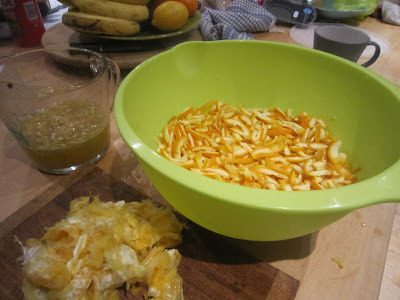 Bitter Seville oranges are in the shops here (for a few weeks only), so it's time to make enough marmalade to see us through till next year. In fact, I slice up the orange peel before boiling it, unlike Polly and Iris in the still room. And now of course, sugar comes already ground in a bag rather than in the solid cone of Victorian times, which makes life easier. This recipe originally came from the River Cottage Preserves recipe book, and their website is a mine of information.
Bitter Seville oranges are in the shops here (for a few weeks only), so it's time to make enough marmalade to see us through till next year. In fact, I slice up the orange peel before boiling it, unlike Polly and Iris in the still room. And now of course, sugar comes already ground in a bag rather than in the solid cone of Victorian times, which makes life easier. This recipe originally came from the River Cottage Preserves recipe book, and their website is a mine of information. You will need:
1 kg/ 2 lb Seville oranges (or you can use a mixture of oranges, grapefruit, lemons etc)
The juice of 2 - 3 lemons (about 75 ml/1/3 cup)
2 kg/4 lb brown demerara sugar
About 7 - 9 clean jam jars with lids
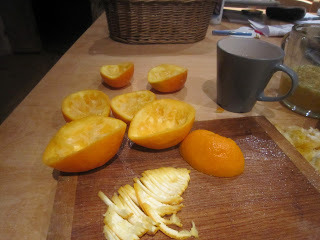 Scrub the oranges and remove the stalk 'buttons'; cut them in half and squeeze the juice and pips into a jug. You then need to slice the peel thinly. I find the easiest way to do this is to cut the orange halves into quarters, turn them over so the white pith is uppermost, peel away and discard the skin, then slice the peel as finely as possible with a serrated knife. It's quite a boring job, but listening to the radio makes the time pass!
Scrub the oranges and remove the stalk 'buttons'; cut them in half and squeeze the juice and pips into a jug. You then need to slice the peel thinly. I find the easiest way to do this is to cut the orange halves into quarters, turn them over so the white pith is uppermost, peel away and discard the skin, then slice the peel as finely as possible with a serrated knife. It's quite a boring job, but listening to the radio makes the time pass!Tip the peel into a large bowl and sieve in the juice - but don't discard the pips, which are a good source of pectin. Tie them up in a square of muslin and add to the bowl. Cover with 2 1/2 litres (10 cups) of water and leave overnight to steep.
In the morning, tip the peel, juice and water into a preserving pan or large saucepan, bring to the boil and simmer gently, partially covered, for about 2 hours, or until the peel is soft. Take out and discard the bag of pips. Now put a saucer in the freezer to get cold so that later you can test for the setting point.
Add the sugar and lemon juice to the pan and heat gently, stirring from time to time, until the sugar has dissolved. Then turn up the heat and boil briskly (I think the professionals call this a 'rolling boil') for about 20 - 25 minutes. Drop a teaspoonful of the hot mixture on to the cold saucer and push it with your finger - if a crinkle forms and the liquid seems to be holding its shape, the marmalade is ready. Take off the heat, leave for about 10 minutes to cool a little, then stir to disperse any scum. Pour into warm, sterilised jam jars and seal with the lids immediately.
Voila! Delicious marmalade. Try not to eat it all by February.... (It makes a great present, too.)
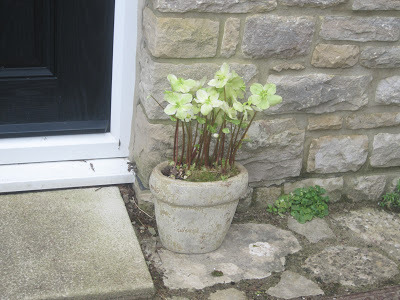
Published on January 20, 2013 10:29
January 15, 2013
Farewell to Rascal, a loyal writing companion
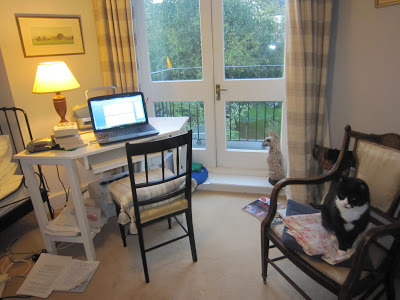 I hope you'll forgive a rather sentimental post today (and those not particularly keen on animals should stop reading now), but I have been thinking a great deal recently about our much-loved cat, Rascal, whom we had to have put to sleep last year. It wasn't unexpected: he was nearly 18 and clearly failing (in fact very miserable during the last week of his life). I was away at the time so my husband had to take him to the vet and make the final decision, and when I came home, the house was empty. Rascal had disappeared from our life as suddenly and discreetly as he'd entered it, and an era was over. This is the first time I've tried to write a book without his basilisk stare and rumbling purr from the other side of the desk, and it doesn't feel the same. He liked to settle as close to the keyboard as possible, having walked over it first, and once managed to delete three pages of work by treading on the alt, control and delete keys. (I'm convinced it was a deliberate plea for attention.)
I hope you'll forgive a rather sentimental post today (and those not particularly keen on animals should stop reading now), but I have been thinking a great deal recently about our much-loved cat, Rascal, whom we had to have put to sleep last year. It wasn't unexpected: he was nearly 18 and clearly failing (in fact very miserable during the last week of his life). I was away at the time so my husband had to take him to the vet and make the final decision, and when I came home, the house was empty. Rascal had disappeared from our life as suddenly and discreetly as he'd entered it, and an era was over. This is the first time I've tried to write a book without his basilisk stare and rumbling purr from the other side of the desk, and it doesn't feel the same. He liked to settle as close to the keyboard as possible, having walked over it first, and once managed to delete three pages of work by treading on the alt, control and delete keys. (I'm convinced it was a deliberate plea for attention.)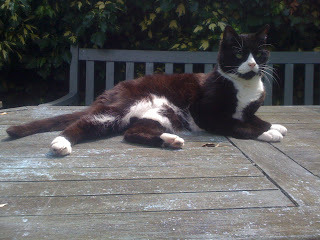
We first met Rascal at the Battersea Cats' and Dogs' Home, where he had been brought as an abandoned five-month-old kitten. At first sight he seemed a very ordinary little black-and-white cat, but when I picked him up, I couldn't believe the softness of his fur. He put one paw on either side of my neck and fixed me intently with his big yellow eyes. I understood exactly what he was saying: 'Take me home'. And so we did.
We discovered very quickly that Rascal was a Cat of Character. He particularly loved milk (though it upset his stomach) and used to appear regularly at breakfast, sitting bolt upright at the table on an empty chair and waiting for the moment when he could reach out to swipe some cereal from an unfinished bowl or surreptitiously dip his paw into the milk jug. (He would eat catfood from the tin with his paw too.) If caught in the act, he would immediately look away or pretend to be washing himself. And when I went to visit a friend in the next road, he would follow me through the neighbours' front gardens, miaowing all the way, then wait by her front door until I'd emerged and he could accompany me home again. Perhaps he thought I might get lost.
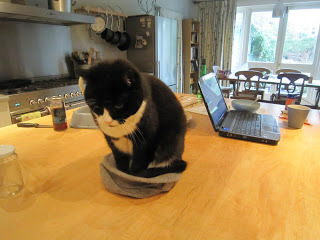 Engaged on one his favourite activities: sitting in something
Engaged on one his favourite activities: sitting in somethingHe also had a fine line in outrage. When we got our first dog, a small terrier, Rascal was so appalled that he moved out of our house and went to live with the old lady over the road. Should he happen to catch sight of any of us on our way to school or work, he would miaow indignantly, or even hiss if he was feeling particularly cross. Sadly the old lady became ill so Rascal reluctantly returned home; he managed to live with the dog by pretending he simply didn't exist.
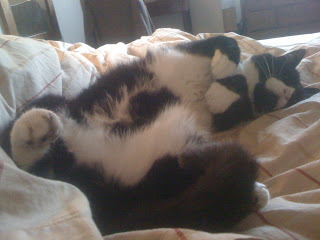 And another: sleeping Things went from bad to worse on the dog front, however, for a few years later the terrier died and we replaced him with a bouncy rescue puppy who grew... and grew... and grew. Rascal was appalled. Eventually, however, he realised that although he was about a tenth the size of this enormous interloper, he was at least ten times as clever. We once witnessed a particularly fiendish trick of his which reduced the dog to a quivering wreck. Noticing Monty underneath the kitchen table on which he happened to be sitting, Rascal crept silently to the edge and swiped him across the head, before immediately retreating to the centre of the table, out of sight. Monty leapt to his feet and stared around. Unable to see his assailant, he became so terrified that he ran straight out of the kitchen and hid in the cupboard under the stairs.
And another: sleeping Things went from bad to worse on the dog front, however, for a few years later the terrier died and we replaced him with a bouncy rescue puppy who grew... and grew... and grew. Rascal was appalled. Eventually, however, he realised that although he was about a tenth the size of this enormous interloper, he was at least ten times as clever. We once witnessed a particularly fiendish trick of his which reduced the dog to a quivering wreck. Noticing Monty underneath the kitchen table on which he happened to be sitting, Rascal crept silently to the edge and swiped him across the head, before immediately retreating to the centre of the table, out of sight. Monty leapt to his feet and stared around. Unable to see his assailant, he became so terrified that he ran straight out of the kitchen and hid in the cupboard under the stairs. 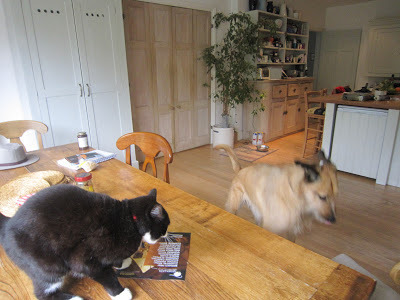 After a similar run-in
After a similar run-inI miss Rascal hugely: miss his softness when times are hard and comfort is needed, miss his indignant face and the sight of him trotting across the garden on some rascally mission. He used to remind me of the Walt Whitman poem:
“I think I could turn and live with the animals, they are so placid and self contained;
I stand and look at them long and long.
They do not sweat and whine about their condition;
They do not lie awake in the dark and weep for their sins;
They do not make me sick discussing their duty to God;
Not one is dissatisfied - not one is demented with the mania of owning things;
Not one kneels to another, nor his kind that lived thousands of years ago;
Not one is responsible or industrious over the whole earth.”
Thank you, Rascal, for all the joy and laughter you've brought us over the years. Taking you home from Battersea was one of the best things we ever did.
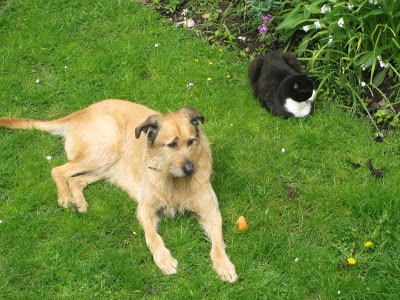 Monty, guarding a carrot; Rascal, pretending he doesn't exist
Monty, guarding a carrot; Rascal, pretending he doesn't exist
Published on January 15, 2013 07:26
January 11, 2013
Five favourite English country houses
Following the pattern of my five favourite Edwardian memoirs in a previous post, here in no particular order are my five favourite English country houses. I'm almost certain to have left out your personal favourite, but these are the houses that I'm drawn to - the houses that seem to 'speak' to me in some indefinable way, to offer up a little of their history.
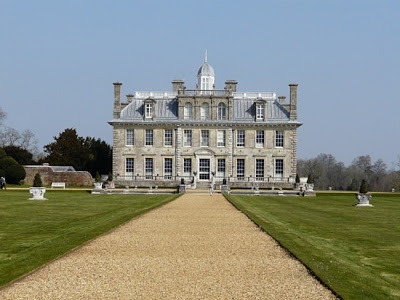 Kingston LacyFirst off is Kingston Lacy in Dorset, to the south-west of England. A neatly symmetrical house built of grey stone in the seventeenth century and re-modelled in the nineteenth by Sir Charles Barry, who designed the Houses of Parliament, this was the place I had at the back of my mind when I first started writing my Swallowcliffe Hall books. It is certainly imposing, standing in acres of lush grounds, but on a more accessible scale than huge edifices like Blenheim Palace, where Sir Winston Churchill was born. Kingston Lacy is just as lovely inside as out, being stuffed with paintings and antique furniture, but you can also see less formal rooms like the Day and Night Nurseries, which are a reminder that this amazing house was also a family home. The Bankes family lived there for over three hundred years (having moved from nearby Corfe Castle when it was destroyed in the Civil War), and the reminiscences of Viola Bankes have been collected in this fascinating book: A Kingston Lacy Childhood. It's a wonderful account of how it felt to grow up as part of an Edwardian aristocratic family, with all its inflexible rules and stifling traditions. Highly recommended!
Kingston LacyFirst off is Kingston Lacy in Dorset, to the south-west of England. A neatly symmetrical house built of grey stone in the seventeenth century and re-modelled in the nineteenth by Sir Charles Barry, who designed the Houses of Parliament, this was the place I had at the back of my mind when I first started writing my Swallowcliffe Hall books. It is certainly imposing, standing in acres of lush grounds, but on a more accessible scale than huge edifices like Blenheim Palace, where Sir Winston Churchill was born. Kingston Lacy is just as lovely inside as out, being stuffed with paintings and antique furniture, but you can also see less formal rooms like the Day and Night Nurseries, which are a reminder that this amazing house was also a family home. The Bankes family lived there for over three hundred years (having moved from nearby Corfe Castle when it was destroyed in the Civil War), and the reminiscences of Viola Bankes have been collected in this fascinating book: A Kingston Lacy Childhood. It's a wonderful account of how it felt to grow up as part of an Edwardian aristocratic family, with all its inflexible rules and stifling traditions. Highly recommended!
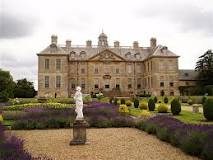 Belton HouseRather similar to Kingston Lacy is Belton House, near Grantham in Lincolnshire, in the Midlands. Now run by the National Trust (as is Kingston Lacy), the house was home to the Brownlow family until the 1980s, when the seventh Lord Brownlow gave the house and gardens to the Trust. I like the house and the treasures inside (including the most enormous piece of silver I've ever seen: a huge wine cooler that would need two footmen to lift), but I think it's the grounds that I love the most. I've borrowed several features to use in my books: the Belmount Tower, for example, which stands on a hill above Belton, has become the Fairview Tower at Swallowcliffe, and the boathouse which features in both Polly's and Isobel's Stories is inspired by the one that overlooks Belton's lake. An important scene in my teen novel,
See You in My Dreams
, also takes place in an orangerie exactly like that at Belton House. I also find Belton fascinating because of the part it played in history: mainly the abdication crisis of 1936, when the Prince of Wales renounced his claim to the throne to marry Wallis Simpson, an American divorcee. Peregrine Cust, the sixth Lord Brownlow, was a great friend of the Prince's, who sometimes stayed at Belton - as did Wallis Simpson. When Edward succeeded to the throne in January 1936, Lord Brownlow was appointed Lord-in-Waiting to the King, and advised him throughout the whole debacle. In later years, it was also rumoured that Princess Diana wanted to buy Belton House and move there from Highgrove, which was rather too close to the home of Camilla Parker-Bowles for comfort, although nothing came of that and it may just have been a story dreamed up by a canny estate agent!
Belton HouseRather similar to Kingston Lacy is Belton House, near Grantham in Lincolnshire, in the Midlands. Now run by the National Trust (as is Kingston Lacy), the house was home to the Brownlow family until the 1980s, when the seventh Lord Brownlow gave the house and gardens to the Trust. I like the house and the treasures inside (including the most enormous piece of silver I've ever seen: a huge wine cooler that would need two footmen to lift), but I think it's the grounds that I love the most. I've borrowed several features to use in my books: the Belmount Tower, for example, which stands on a hill above Belton, has become the Fairview Tower at Swallowcliffe, and the boathouse which features in both Polly's and Isobel's Stories is inspired by the one that overlooks Belton's lake. An important scene in my teen novel,
See You in My Dreams
, also takes place in an orangerie exactly like that at Belton House. I also find Belton fascinating because of the part it played in history: mainly the abdication crisis of 1936, when the Prince of Wales renounced his claim to the throne to marry Wallis Simpson, an American divorcee. Peregrine Cust, the sixth Lord Brownlow, was a great friend of the Prince's, who sometimes stayed at Belton - as did Wallis Simpson. When Edward succeeded to the throne in January 1936, Lord Brownlow was appointed Lord-in-Waiting to the King, and advised him throughout the whole debacle. In later years, it was also rumoured that Princess Diana wanted to buy Belton House and move there from Highgrove, which was rather too close to the home of Camilla Parker-Bowles for comfort, although nothing came of that and it may just have been a story dreamed up by a canny estate agent!
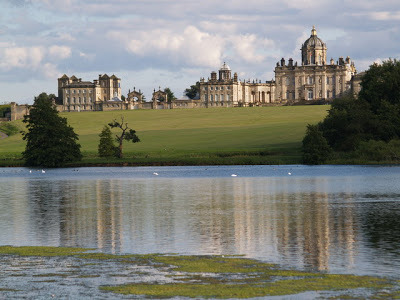 Castle Howard
Castle Howard
A two-hour train journey north from Grantham takes you to the city of York, and from there you can take a coach to probably the most beautiful house I've ever seen: Castle Howard. When I first visited in 1999, Christian, the elder daughter of Geoffrey Howard the Liberal MP, had just died, and there were family flowers for her in the chapel - a personal touch which made me feel like an intruder in somebody's private home. The house is on a much larger scale than the two previous ones, and is full of views and treasures that will take your breath away. The television and film adaptations of Evelyn Waugh's novel Brideshead Revisited were filmed at Castle Howard, although the book, Madresfield: the Real Brideshead, by Jane Mulvagh, makes the point that Waugh had a smaller, homelier house in mind when he wrote this novel. He was a friend of the Lygon family, who lived at Madresfield, and was a frequent visitor there. Jane Mulvagh's book is an engrossing account of one country house through the ages and the various generations who have inhabited it.
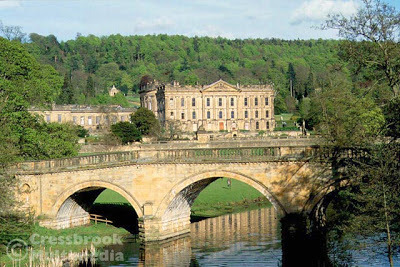 Chatsworth House, www.peakdistrictinformation.com
Chatsworth House, www.peakdistrictinformation.com
Another country house on a vast scale is Chatsworth House, a little further south from Castle Howard in the beautiful Peak District. The first sight of Chatsworth, standing proudly against the wooded hills behind, always makes the hair stand up on the back of my neck. It has been lived in by the Dukes of Devonshire since the seventeenth century, and was one of the first country houses to develop commercially and become self-financing as a tourist attraction. Deborah, the youngest and last of the famous Mitford sisters still living (described by journalist Ben Macintyre as 'Diana the Fascist, Jessica the Communist, Unity the Hitler-lover, Nancy the Novelist, Deborah the Duchess and Pamela the unobtrusive poultry connoisseur,') is the eleventh (now Dowager) Duchess of Devonshire and is a witty and accomplished writer. Her book, Wait for Me: Memoirs of the Youngest Mitford Sister, is another must-read for anyone interested in the English country-house world, as is The Chatsworth Cookery Book. On a personal note: my family lived near the Peak District when I was a teenager, and my parents met the Duchess several times. She was always completely charming and down-to-earth - a lady through and through. Her son has since inherited the title, and she now lives happily in a Dower House on the Chatsworth Estate. It's typical of her lack of pretension that she once described the main house as 'a terrible place to house-train a puppy'.
 Leeds CastleAnd last but not least, in Kent, to the south-east of England, lies the fairy-tale Leeds Castle, the oldest of these houses, which was originally a Saxon manor dating from the ninth century. Surrounded by a moat, the castle has the most gorgeous gardens and is particularly lovely to visit in the spring, when the carpets of daffodils are blooming. Heavy death duties meant the place had to be sold in the 1920s by the Wykeham Martin family, who had owned it for a century (relative newcomers!). Randolph Hearst, the American newspaper magnate, was looking to buy an English castle (as you do), but so much work was needed, he was discouraged, and it was eventually acquired by the Hon. Mrs Wilson-Filmer, later Lady Baillie. She transformed the castle into one of the great houses of England and entertained politicians, various royals and film stars within its secluded walls. During the Second World War, the castle became a military hospital (as Swallowcliffe Hall became in the First), and later Lady Baillie bequeathed it to the nation. I love this portrait of her with her daughters, painted in1947; she is smoking so insouciantly, staring straight out of the picture, while her daughters (two elegant English roses) look shyly into the distance.
Leeds CastleAnd last but not least, in Kent, to the south-east of England, lies the fairy-tale Leeds Castle, the oldest of these houses, which was originally a Saxon manor dating from the ninth century. Surrounded by a moat, the castle has the most gorgeous gardens and is particularly lovely to visit in the spring, when the carpets of daffodils are blooming. Heavy death duties meant the place had to be sold in the 1920s by the Wykeham Martin family, who had owned it for a century (relative newcomers!). Randolph Hearst, the American newspaper magnate, was looking to buy an English castle (as you do), but so much work was needed, he was discouraged, and it was eventually acquired by the Hon. Mrs Wilson-Filmer, later Lady Baillie. She transformed the castle into one of the great houses of England and entertained politicians, various royals and film stars within its secluded walls. During the Second World War, the castle became a military hospital (as Swallowcliffe Hall became in the First), and later Lady Baillie bequeathed it to the nation. I love this portrait of her with her daughters, painted in1947; she is smoking so insouciantly, staring straight out of the picture, while her daughters (two elegant English roses) look shyly into the distance.
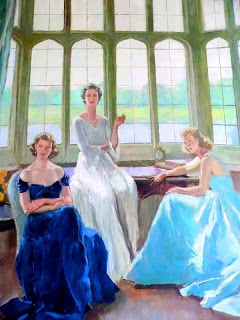
So these are my favourite country houses. I've left out Sissinghurst with its wonderful gardens created by Vita Sackville-West and Harold Nicholson, and Chartwell, Winston Churchill's beloved family home, and romantic Ightam Mote, and many hundreds more - not to mention Highclere Castle, where Downton Abbey is filmed. Which house would you like to live in, if you could choose?
 Kingston LacyFirst off is Kingston Lacy in Dorset, to the south-west of England. A neatly symmetrical house built of grey stone in the seventeenth century and re-modelled in the nineteenth by Sir Charles Barry, who designed the Houses of Parliament, this was the place I had at the back of my mind when I first started writing my Swallowcliffe Hall books. It is certainly imposing, standing in acres of lush grounds, but on a more accessible scale than huge edifices like Blenheim Palace, where Sir Winston Churchill was born. Kingston Lacy is just as lovely inside as out, being stuffed with paintings and antique furniture, but you can also see less formal rooms like the Day and Night Nurseries, which are a reminder that this amazing house was also a family home. The Bankes family lived there for over three hundred years (having moved from nearby Corfe Castle when it was destroyed in the Civil War), and the reminiscences of Viola Bankes have been collected in this fascinating book: A Kingston Lacy Childhood. It's a wonderful account of how it felt to grow up as part of an Edwardian aristocratic family, with all its inflexible rules and stifling traditions. Highly recommended!
Kingston LacyFirst off is Kingston Lacy in Dorset, to the south-west of England. A neatly symmetrical house built of grey stone in the seventeenth century and re-modelled in the nineteenth by Sir Charles Barry, who designed the Houses of Parliament, this was the place I had at the back of my mind when I first started writing my Swallowcliffe Hall books. It is certainly imposing, standing in acres of lush grounds, but on a more accessible scale than huge edifices like Blenheim Palace, where Sir Winston Churchill was born. Kingston Lacy is just as lovely inside as out, being stuffed with paintings and antique furniture, but you can also see less formal rooms like the Day and Night Nurseries, which are a reminder that this amazing house was also a family home. The Bankes family lived there for over three hundred years (having moved from nearby Corfe Castle when it was destroyed in the Civil War), and the reminiscences of Viola Bankes have been collected in this fascinating book: A Kingston Lacy Childhood. It's a wonderful account of how it felt to grow up as part of an Edwardian aristocratic family, with all its inflexible rules and stifling traditions. Highly recommended! Belton HouseRather similar to Kingston Lacy is Belton House, near Grantham in Lincolnshire, in the Midlands. Now run by the National Trust (as is Kingston Lacy), the house was home to the Brownlow family until the 1980s, when the seventh Lord Brownlow gave the house and gardens to the Trust. I like the house and the treasures inside (including the most enormous piece of silver I've ever seen: a huge wine cooler that would need two footmen to lift), but I think it's the grounds that I love the most. I've borrowed several features to use in my books: the Belmount Tower, for example, which stands on a hill above Belton, has become the Fairview Tower at Swallowcliffe, and the boathouse which features in both Polly's and Isobel's Stories is inspired by the one that overlooks Belton's lake. An important scene in my teen novel,
See You in My Dreams
, also takes place in an orangerie exactly like that at Belton House. I also find Belton fascinating because of the part it played in history: mainly the abdication crisis of 1936, when the Prince of Wales renounced his claim to the throne to marry Wallis Simpson, an American divorcee. Peregrine Cust, the sixth Lord Brownlow, was a great friend of the Prince's, who sometimes stayed at Belton - as did Wallis Simpson. When Edward succeeded to the throne in January 1936, Lord Brownlow was appointed Lord-in-Waiting to the King, and advised him throughout the whole debacle. In later years, it was also rumoured that Princess Diana wanted to buy Belton House and move there from Highgrove, which was rather too close to the home of Camilla Parker-Bowles for comfort, although nothing came of that and it may just have been a story dreamed up by a canny estate agent!
Belton HouseRather similar to Kingston Lacy is Belton House, near Grantham in Lincolnshire, in the Midlands. Now run by the National Trust (as is Kingston Lacy), the house was home to the Brownlow family until the 1980s, when the seventh Lord Brownlow gave the house and gardens to the Trust. I like the house and the treasures inside (including the most enormous piece of silver I've ever seen: a huge wine cooler that would need two footmen to lift), but I think it's the grounds that I love the most. I've borrowed several features to use in my books: the Belmount Tower, for example, which stands on a hill above Belton, has become the Fairview Tower at Swallowcliffe, and the boathouse which features in both Polly's and Isobel's Stories is inspired by the one that overlooks Belton's lake. An important scene in my teen novel,
See You in My Dreams
, also takes place in an orangerie exactly like that at Belton House. I also find Belton fascinating because of the part it played in history: mainly the abdication crisis of 1936, when the Prince of Wales renounced his claim to the throne to marry Wallis Simpson, an American divorcee. Peregrine Cust, the sixth Lord Brownlow, was a great friend of the Prince's, who sometimes stayed at Belton - as did Wallis Simpson. When Edward succeeded to the throne in January 1936, Lord Brownlow was appointed Lord-in-Waiting to the King, and advised him throughout the whole debacle. In later years, it was also rumoured that Princess Diana wanted to buy Belton House and move there from Highgrove, which was rather too close to the home of Camilla Parker-Bowles for comfort, although nothing came of that and it may just have been a story dreamed up by a canny estate agent! Castle Howard
Castle HowardA two-hour train journey north from Grantham takes you to the city of York, and from there you can take a coach to probably the most beautiful house I've ever seen: Castle Howard. When I first visited in 1999, Christian, the elder daughter of Geoffrey Howard the Liberal MP, had just died, and there were family flowers for her in the chapel - a personal touch which made me feel like an intruder in somebody's private home. The house is on a much larger scale than the two previous ones, and is full of views and treasures that will take your breath away. The television and film adaptations of Evelyn Waugh's novel Brideshead Revisited were filmed at Castle Howard, although the book, Madresfield: the Real Brideshead, by Jane Mulvagh, makes the point that Waugh had a smaller, homelier house in mind when he wrote this novel. He was a friend of the Lygon family, who lived at Madresfield, and was a frequent visitor there. Jane Mulvagh's book is an engrossing account of one country house through the ages and the various generations who have inhabited it.
 Chatsworth House, www.peakdistrictinformation.com
Chatsworth House, www.peakdistrictinformation.comAnother country house on a vast scale is Chatsworth House, a little further south from Castle Howard in the beautiful Peak District. The first sight of Chatsworth, standing proudly against the wooded hills behind, always makes the hair stand up on the back of my neck. It has been lived in by the Dukes of Devonshire since the seventeenth century, and was one of the first country houses to develop commercially and become self-financing as a tourist attraction. Deborah, the youngest and last of the famous Mitford sisters still living (described by journalist Ben Macintyre as 'Diana the Fascist, Jessica the Communist, Unity the Hitler-lover, Nancy the Novelist, Deborah the Duchess and Pamela the unobtrusive poultry connoisseur,') is the eleventh (now Dowager) Duchess of Devonshire and is a witty and accomplished writer. Her book, Wait for Me: Memoirs of the Youngest Mitford Sister, is another must-read for anyone interested in the English country-house world, as is The Chatsworth Cookery Book. On a personal note: my family lived near the Peak District when I was a teenager, and my parents met the Duchess several times. She was always completely charming and down-to-earth - a lady through and through. Her son has since inherited the title, and she now lives happily in a Dower House on the Chatsworth Estate. It's typical of her lack of pretension that she once described the main house as 'a terrible place to house-train a puppy'.
 Leeds CastleAnd last but not least, in Kent, to the south-east of England, lies the fairy-tale Leeds Castle, the oldest of these houses, which was originally a Saxon manor dating from the ninth century. Surrounded by a moat, the castle has the most gorgeous gardens and is particularly lovely to visit in the spring, when the carpets of daffodils are blooming. Heavy death duties meant the place had to be sold in the 1920s by the Wykeham Martin family, who had owned it for a century (relative newcomers!). Randolph Hearst, the American newspaper magnate, was looking to buy an English castle (as you do), but so much work was needed, he was discouraged, and it was eventually acquired by the Hon. Mrs Wilson-Filmer, later Lady Baillie. She transformed the castle into one of the great houses of England and entertained politicians, various royals and film stars within its secluded walls. During the Second World War, the castle became a military hospital (as Swallowcliffe Hall became in the First), and later Lady Baillie bequeathed it to the nation. I love this portrait of her with her daughters, painted in1947; she is smoking so insouciantly, staring straight out of the picture, while her daughters (two elegant English roses) look shyly into the distance.
Leeds CastleAnd last but not least, in Kent, to the south-east of England, lies the fairy-tale Leeds Castle, the oldest of these houses, which was originally a Saxon manor dating from the ninth century. Surrounded by a moat, the castle has the most gorgeous gardens and is particularly lovely to visit in the spring, when the carpets of daffodils are blooming. Heavy death duties meant the place had to be sold in the 1920s by the Wykeham Martin family, who had owned it for a century (relative newcomers!). Randolph Hearst, the American newspaper magnate, was looking to buy an English castle (as you do), but so much work was needed, he was discouraged, and it was eventually acquired by the Hon. Mrs Wilson-Filmer, later Lady Baillie. She transformed the castle into one of the great houses of England and entertained politicians, various royals and film stars within its secluded walls. During the Second World War, the castle became a military hospital (as Swallowcliffe Hall became in the First), and later Lady Baillie bequeathed it to the nation. I love this portrait of her with her daughters, painted in1947; she is smoking so insouciantly, staring straight out of the picture, while her daughters (two elegant English roses) look shyly into the distance.
So these are my favourite country houses. I've left out Sissinghurst with its wonderful gardens created by Vita Sackville-West and Harold Nicholson, and Chartwell, Winston Churchill's beloved family home, and romantic Ightam Mote, and many hundreds more - not to mention Highclere Castle, where Downton Abbey is filmed. Which house would you like to live in, if you could choose?
Published on January 11, 2013 09:25



